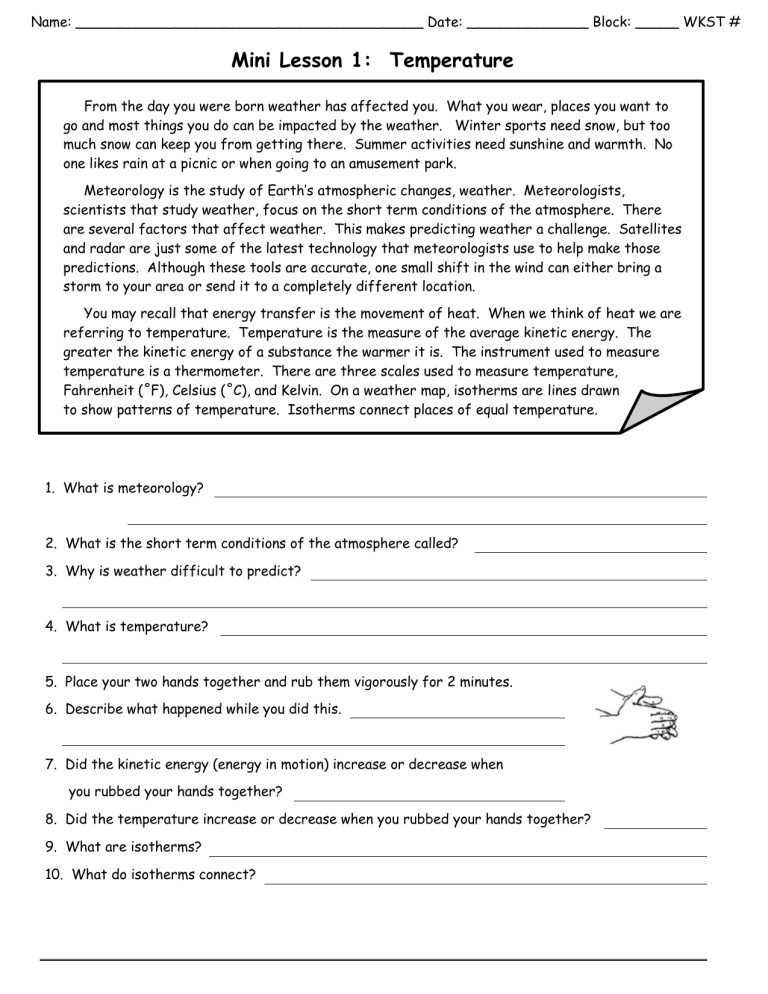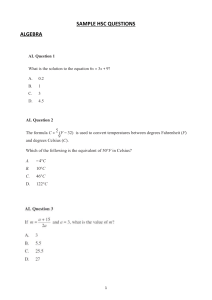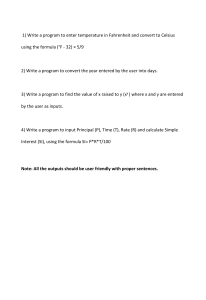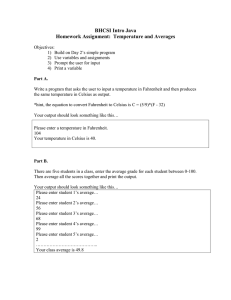
Name: ________________________________________ Date: ______________ Block: _____ WKST # Mini Lesson 1: Temperature From the day you were born weather has affected you. What you wear, places you want to go and most things you do can be impacted by the weather. Winter sports need snow, but too much snow can keep you from getting there. Summer activities need sunshine and warmth. No one likes rain at a picnic or when going to an amusement park. Meteorology is the study of Earth’s atmospheric changes, weather. Meteorologists, scientists that study weather, focus on the short term conditions of the atmosphere. There are several factors that affect weather. This makes predicting weather a challenge. Satellites and radar are just some of the latest technology that meteorologists use to help make those predictions. Although these tools are accurate, one small shift in the wind can either bring a storm to your area or send it to a completely different location. You may recall that energy transfer is the movement of heat. When we think of heat we are referring to temperature. Temperature is the measure of the average kinetic energy. The greater the kinetic energy of a substance the warmer it is. The instrument used to measure temperature is a thermometer. There are three scales used to measure temperature, Fahrenheit (˚F), Celsius (˚C), and Kelvin. On a weather map, isotherms are lines drawn to show patterns of temperature. Isotherms connect places of equal temperature. 1. What is meteorology? 2. What is the short term conditions of the atmosphere called? 3. Why is weather difficult to predict? 4. What is temperature? 5. Place your two hands together and rub them vigorously for 2 minutes. 6. Describe what happened while you did this. 7. Did the kinetic energy (energy in motion) increase or decrease when you rubbed your hands together? 8. Did the temperature increase or decrease when you rubbed your hands together? 9. What are isotherms? 10. What do isotherms connect? “Temperature” Earth Science Reference Tables page 13 1. Write the names and symbols of the three scales on the chart? ˚ ˚ 2. Look at the scale in the first column (Fahrenheit). How many degrees does each line count by? ˚F 3. Look at the scale in the second column (Celsius). How many degrees does each line count by? ˚F 4. Look at the scale in the third column (Kelvin). How ˚F many degrees does each line count by? 5. Find the following temperatures using page 14 in your ESRT. Celcius Tropopause Stratopause Mesopause 6. Practice: Convert the temperatures below by using the conversion chart in the Earth Science Reference Tables. Fahrenheit Celsius Kelvin 20 70 260 40 60 290 -40 240 75 50 Regents Questions: Base your answers to questions 1 through 3 on the field map provided below. The field map shows air temperature at specific locations in an area near a school in New York State. Part of this area is a blacktop parking lot. Accurate temperature readings were taken by Earth science students at 10 a.m. on June 1. Two reference points, A and B, are shown. 1. On the field map provided to the right, draw only the 15°C and the 20°C isotherms. Isotherms must be extended to the edge of the map. 2. Surface temperatures are higher on the east side of the field map, where the parking lot is located. Explain how a characteristic of the parking lot surface could cause these higher temperatures. 3. Calculate the temperature gradient along a straight line between point A and point B on the map by following the directions below. a) Write the equation for determining the temperature gradient. b) Substitute the correct values into the equation. c) Solve the equation and record your answer in decimal form. Label the answer with the correct units. 5. The field map to the right shows air temperature measurements, in degrees Celsius, taken at the same elevation within a closed room. Two reference points, A and B, are shown. Draw the isolines for 18˚, 20˚,22˚,24˚,26 and,28˚. 6. Calculate the temperature gradient along a straight line between point A and point B on the map by following the directions below. a) Write the equation for determining the temperature gradient. b) Substitute the correct values into the equation. c) Solve the equation and record your answer in decimal form. Label the answer with the correct units. 7. On the map provided, draw the 40°F, 50°F, 60°F, 70°F and 80°F isotherms. Extend the isotherm to the edges of the continent. 1. Which weather instrument is used to measure air temperatures recorded on a weather map? A) anemometer C) thermometer B) wind vane D) barometer 2. A temperature of 104°F is approximately equal to A) 220°C C) 43°C B) 214°C D) 40°C 3. An air temperature of 30°C is equal to A) –22°F C) 74°F B) –2°F D) 86°F 4. A temperature of 73° Fahrenheit is approximately equal to a temperature of A) 17° Celsius C) 26° Celsius B) 23° Celsius D) 162° Celsius 5. A temperature of 20°C is equal to a temperature of A) –7°F C) 68°F B) 36°F D) 293°F



![Temperature Notes [9/22/2015]](http://s3.studylib.net/store/data/006907012_1-3fc2d93efdacd086a05519765259a482-300x300.png)
